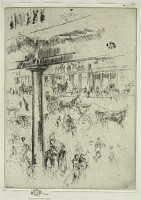Etchings Institutions search term: mclean
Regent's Quadrant | ||
| Number: | 242 | |
| Date: | 1880/1881 | |
| Medium: | etching and drypoint | |
| Size: | 166 x 122 mm | |
| Signed: | butterfly at upper right | |
| Inscribed: | no | |
| Set/Publication: | no | |
| No. of States: | 7 | |
| Known impressions: | 10 | |
| Catalogues: | K.239; M.235; W.192 | |
| Impressions taken from this plate (10) | ||
TECHNIQUE
The original composition in etching was augmented with drypoint line and shading from the second state on (through seven states). The figures have a remarkable immediacy, and are full of character and movement. Individual details of dress and activity are conveyed expressively with broken, jagged lines, dots and dashes. It is clear that Whistler, looking down from the window of the print-studio on the first-floor, was adding and subtracting figures as they caught his eye.
PRINTING
The first three states were printed in the period after Whistler's return from Venice at the end of 1880. There are single proofs of the early states, plus a fewmore impressions of the final state.
The young Thomas Robert Way (1861-1913) helped Whistler to print his Venetian etchings in the rooms at Air Street in 1880/1881:
'I was working in the schools at South Kensington
then, but as Whistler wanted to have some one
with him, I had that privilege during the whole
of this historic time, fetching and carrying, and
preparing his materials, and generally making myself
useful. Among other things, I had to see
to the proper damping of the old Dutch paper,
and its careful brushing to remove any loose hairs
or other matters before it was used for printing
on, and to press the proofs very carefully and
thoroughly, that they might be quite flat before
being seen. He had not then taken to his later
custom of cutting off the margins of the paper
beyond the subject.' 11
11: Way 1912 , pp. 41-43.
In fact impressions of Regent's Quadrant were all trimmed to the platemark by Whistler, and signed on a tab with his butterfly to show that he had printed them. An early impression printed with some burr on ivory laid paper was definitely among those printed in 1880 or 1881 ( ). The following state is signed with a butterfly that looks more like 1882 or 1883 (
). The following state is signed with a butterfly that looks more like 1882 or 1883 ( ). The impressions were all printed in black ink.
). The impressions were all printed in black ink.
 ). The following state is signed with a butterfly that looks more like 1882 or 1883 (
). The following state is signed with a butterfly that looks more like 1882 or 1883 ( ). The impressions were all printed in black ink.
). The impressions were all printed in black ink. On 4 February 1887 Messrs Dowdeswell requested impressions after reading F. Wedmore's catalogue, and Whistler sold them at least eight impressions between April and September 1887. 12
12: GUW #00888; see SALES & COLLECTORS.
Three impressions of this, the final state, have been located, although more were probably printed and sold at that time. Two of these are on the same ivory laid paper ( ,
,  ), with a partial watermark of the Arms of Amsterdam on the latter. The date is confirmed by the form of butterfly signature on the tabs, which appear to date from 1887.
), with a partial watermark of the Arms of Amsterdam on the latter. The date is confirmed by the form of butterfly signature on the tabs, which appear to date from 1887.
 ,
,  ), with a partial watermark of the Arms of Amsterdam on the latter. The date is confirmed by the form of butterfly signature on the tabs, which appear to date from 1887.
), with a partial watermark of the Arms of Amsterdam on the latter. The date is confirmed by the form of butterfly signature on the tabs, which appear to date from 1887.
